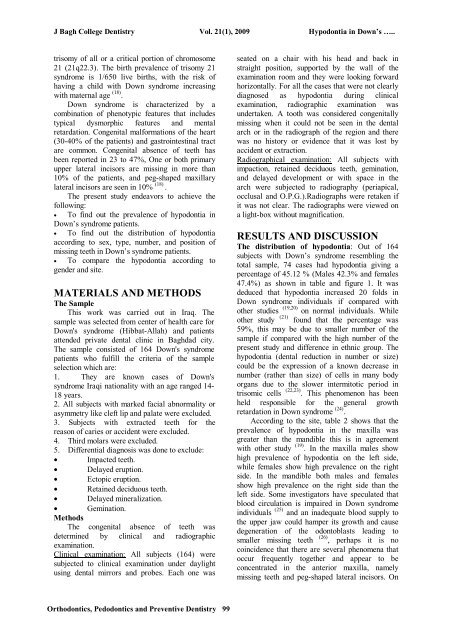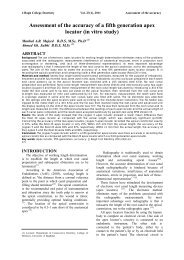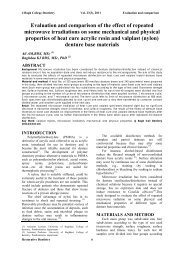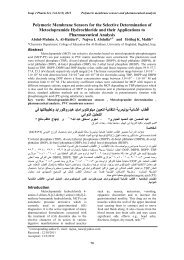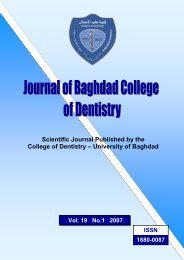Vol 21 No. 1
Vol 21 No. 1
Vol 21 No. 1
Create successful ePaper yourself
Turn your PDF publications into a flip-book with our unique Google optimized e-Paper software.
J Bagh College Dentistry <strong>Vol</strong>. <strong>21</strong>(1), 2009 Hypodontia in Down’s …..<br />
trisomy of all or a critical portion of chromosome<br />
<strong>21</strong> (<strong>21</strong>q22.3). The birth prevalence of trisomy <strong>21</strong><br />
syndrome is 1/650 live births, with the risk of<br />
having a child with Down syndrome increasing<br />
with maternal age (18) .<br />
Down syndrome is characterized by a<br />
combination of phenotypic features that includes<br />
typical dysmorphic features and mental<br />
retardation. Congenital malformations of the heart<br />
(30-40% of the patients) and gastrointestinal tract<br />
are common. Congenital absence of teeth has<br />
been reported in 23 to 47%, One or both primary<br />
upper lateral incisors are missing in more than<br />
10% of the patients, and peg-shaped maxillary<br />
lateral incisors are seen in 10% (18) .<br />
The present study endeavors to achieve the<br />
following:<br />
• To find out the prevalence of hypodontia in<br />
Down’s syndrome patients.<br />
• To find out the distribution of hypodontia<br />
according to sex, type, number, and position of<br />
missing teeth in Down’s syndrome patients.<br />
• To compare the hypodontia according to<br />
gender and site.<br />
MATERIALS AND METHODS<br />
The Sample<br />
This work was carried out in Iraq. The<br />
sample was selected from center of health care for<br />
Down's syndrome (Hibbat-Allah) and patients<br />
attended private dental clinic in Baghdad city.<br />
The sample consisted of 164 Down's syndrome<br />
patients who fulfill the criteria of the sample<br />
selection which are:<br />
1. They are known cases of Down's<br />
syndrome Iraqi nationality with an age ranged 14-<br />
18 years.<br />
2. All subjects with marked facial abnormality or<br />
asymmetry like cleft lip and palate were excluded.<br />
3. Subjects with extracted teeth for the<br />
reason of caries or accident were excluded.<br />
4. Third molars were excluded.<br />
5. Differential diagnosis was done to exclude:<br />
• Impacted teeth.<br />
• Delayed eruption.<br />
• Ectopic eruption.<br />
• Retained deciduous teeth.<br />
• Delayed mineralization.<br />
• Gemination.<br />
Methods<br />
The congenital absence of teeth was<br />
determined by clinical and radiographic<br />
examination.<br />
Clinical examination: All subjects (164) were<br />
subjected to clinical examination under daylight<br />
using dental mirrors and probes. Each one was<br />
seated on a chair with his head and back in<br />
straight position, supported by the wall of the<br />
examination room and they were looking forward<br />
horizontally. For all the cases that were not clearly<br />
diagnosed as hypodontia during clinical<br />
examination, radiographic examination was<br />
undertaken. A tooth was considered congenitally<br />
missing when it could not be seen in the dental<br />
arch or in the radiograph of the region and there<br />
was no history or evidence that it was lost by<br />
accident or extraction.<br />
Radiographical examination: All subjects with<br />
impaction, retained deciduous teeth, gemination,<br />
and delayed development or with space in the<br />
arch were subjected to radiography (periapical,<br />
occlusal and O.P.G.).Radiographs were retaken if<br />
it was not clear. The radiographs were viewed on<br />
a light-box without magnification.<br />
RESULTS AND DISCUSSION<br />
The distribution of hypodontia: Out of 164<br />
subjects with Down’s syndrome resembling the<br />
total sample, 74 cases had hypodontia giving a<br />
percentage of 45.12 % (Males 42.3% and females<br />
47.4%) as shown in table and figure 1. It was<br />
deduced that hypodontia increased 20 folds in<br />
Down syndrome individuals if compared with<br />
other studies (19,20) on normal individuals. While<br />
other study (<strong>21</strong>) found that the percentage was<br />
59%, this may be due to smaller number of the<br />
sample if compared with the high number of the<br />
present study and difference in ethnic group. The<br />
hypodontia (dental reduction in number or size)<br />
could be the expression of a known decrease in<br />
number (rather than size) of cells in many body<br />
organs due to the slower intermitotic period in<br />
trisomic cells (22,23) . This phenomenon has been<br />
held responsible for the general growth<br />
retardation in Down syndrome (24) .<br />
According to the site, table 2 shows that the<br />
prevalence of hypodontia in the maxilla was<br />
greater than the mandible this is in agreement<br />
with other study (19) . In the maxilla males show<br />
high prevalence of hypodontia on the left side,<br />
while females show high prevalence on the right<br />
side. In the mandible both males and females<br />
show high prevalence on the right side than the<br />
left side. Some investigators have speculated that<br />
blood circulation is impaired in Down syndrome<br />
individuals (25) and an inadequate blood supply to<br />
the upper jaw could hamper its growth and cause<br />
degeneration of the odontoblasts leading to<br />
smaller missing teeth (26) , perhaps it is no<br />
coincidence that there are several phenomena that<br />
occur frequently together and appear to be<br />
concentrated in the anterior maxilla, namely<br />
missing teeth and peg-shaped lateral incisors. On<br />
Orthodontics, Pedodontics and Preventive Dentistry 99


